MG411 - People Management: Leadership, Training, and Talent at Nissan
VerifiedAdded on 2023/01/13
|9
|2394
|82
Report
AI Summary
This report examines leadership and management practices within Nissan, focusing on how leadership styles, such as autocratic leadership, and management principles contribute to the company's overall performance. It explores the application of leadership models, including authentic and autocratic models, and management models like Maslow's hierarchy of needs, and the role of operations in achieving business objectives. The report further investigates training and development strategies, analyzing the transitional and instructional system models, and how these initiatives enhance employee skills and contribute to organizational growth. Additionally, it addresses talent management in relation to performance management, outlining the planning and developing models that support talent acquisition, training, and promotion. The analysis concludes with recommendations for Nissan to optimize its leadership and management approaches, including the strategic use of leadership styles and the implementation of effective training and talent management programs, all aimed at improving operational efficiency and employee satisfaction.
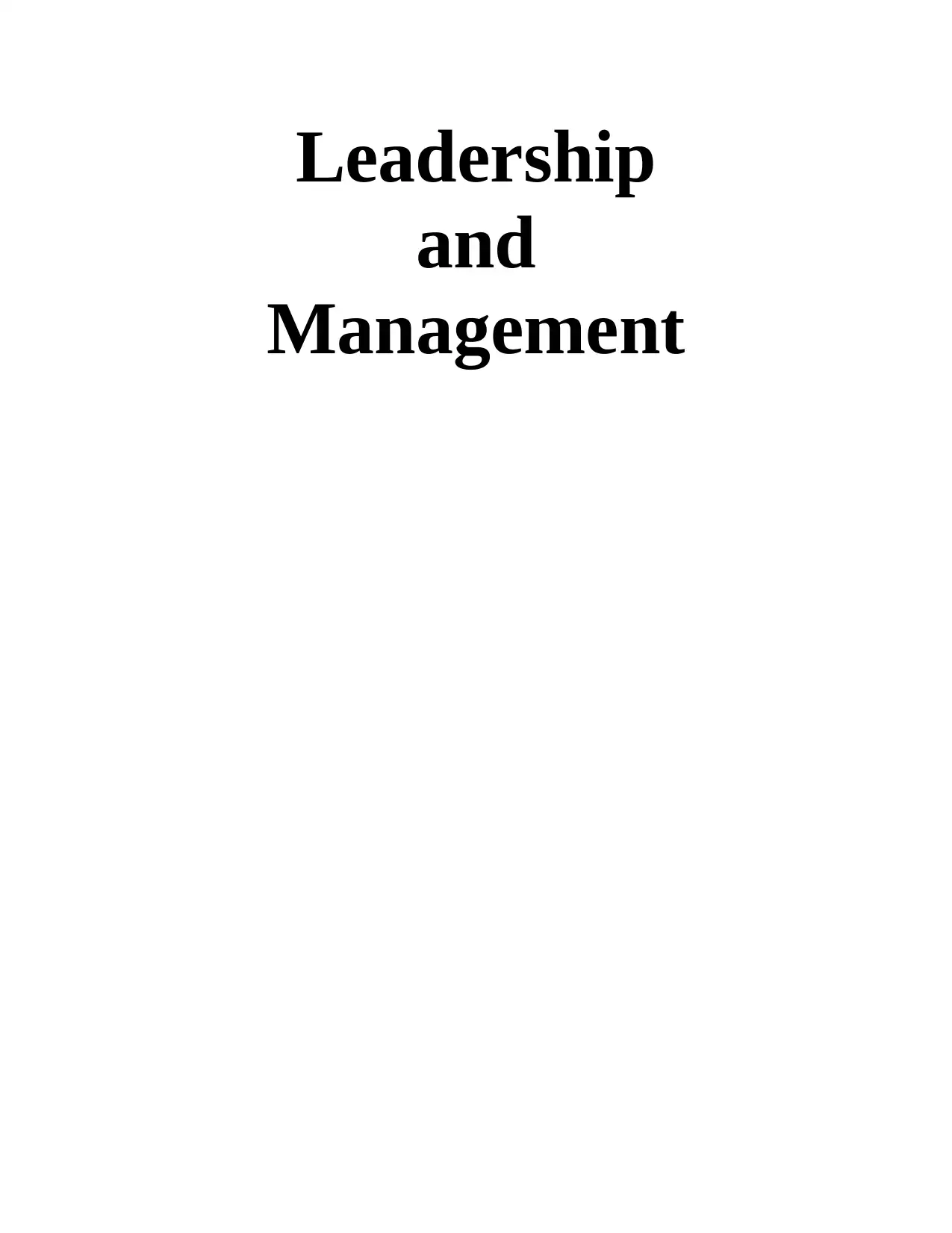
Leadership
and
Management
and
Management
Paraphrase This Document
Need a fresh take? Get an instant paraphrase of this document with our AI Paraphraser
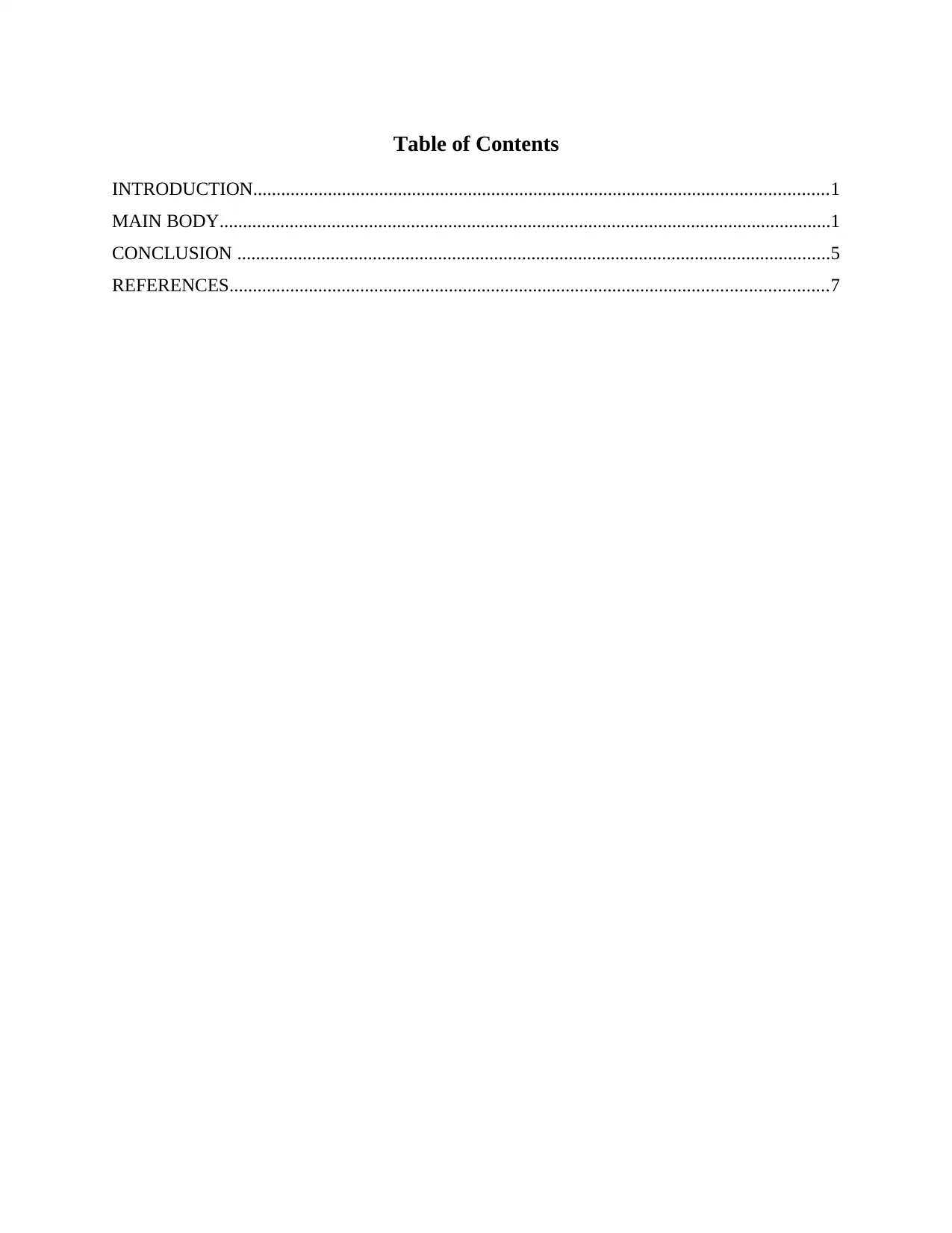
Table of Contents
INTRODUCTION...........................................................................................................................1
MAIN BODY...................................................................................................................................1
CONCLUSION ...............................................................................................................................5
REFERENCES................................................................................................................................7
INTRODUCTION...........................................................................................................................1
MAIN BODY...................................................................................................................................1
CONCLUSION ...............................................................................................................................5
REFERENCES................................................................................................................................7
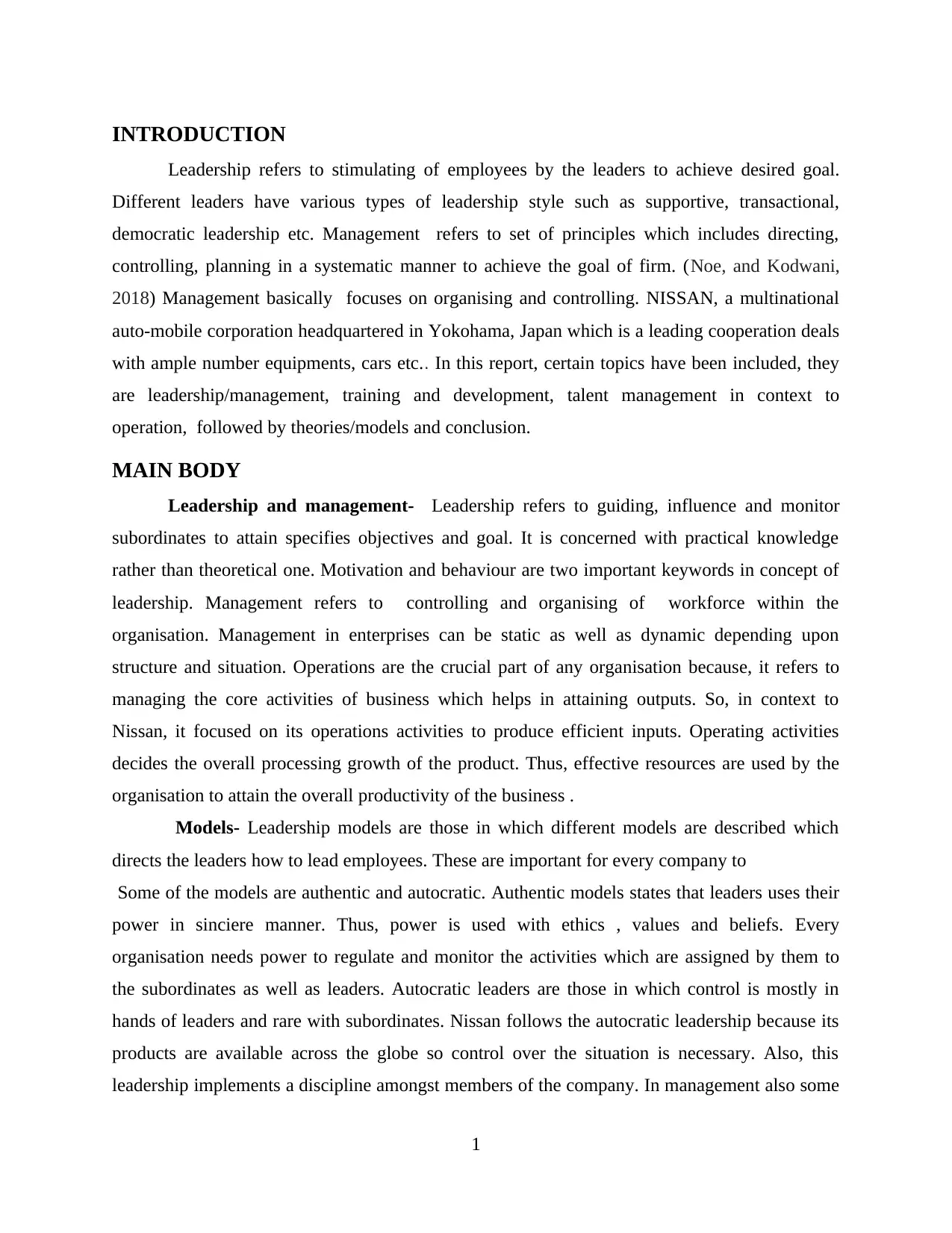
INTRODUCTION
Leadership refers to stimulating of employees by the leaders to achieve desired goal.
Different leaders have various types of leadership style such as supportive, transactional,
democratic leadership etc. Management refers to set of principles which includes directing,
controlling, planning in a systematic manner to achieve the goal of firm. (Noe, and Kodwani,
2018) Management basically focuses on organising and controlling. NISSAN, a multinational
auto-mobile corporation headquartered in Yokohama, Japan which is a leading cooperation deals
with ample number equipments, cars etc.. In this report, certain topics have been included, they
are leadership/management, training and development, talent management in context to
operation, followed by theories/models and conclusion.
MAIN BODY
Leadership and management- Leadership refers to guiding, influence and monitor
subordinates to attain specifies objectives and goal. It is concerned with practical knowledge
rather than theoretical one. Motivation and behaviour are two important keywords in concept of
leadership. Management refers to controlling and organising of workforce within the
organisation. Management in enterprises can be static as well as dynamic depending upon
structure and situation. Operations are the crucial part of any organisation because, it refers to
managing the core activities of business which helps in attaining outputs. So, in context to
Nissan, it focused on its operations activities to produce efficient inputs. Operating activities
decides the overall processing growth of the product. Thus, effective resources are used by the
organisation to attain the overall productivity of the business .
Models- Leadership models are those in which different models are described which
directs the leaders how to lead employees. These are important for every company to
Some of the models are authentic and autocratic. Authentic models states that leaders uses their
power in sinciere manner. Thus, power is used with ethics , values and beliefs. Every
organisation needs power to regulate and monitor the activities which are assigned by them to
the subordinates as well as leaders. Autocratic leaders are those in which control is mostly in
hands of leaders and rare with subordinates. Nissan follows the autocratic leadership because its
products are available across the globe so control over the situation is necessary. Also, this
leadership implements a discipline amongst members of the company. In management also some
1
Leadership refers to stimulating of employees by the leaders to achieve desired goal.
Different leaders have various types of leadership style such as supportive, transactional,
democratic leadership etc. Management refers to set of principles which includes directing,
controlling, planning in a systematic manner to achieve the goal of firm. (Noe, and Kodwani,
2018) Management basically focuses on organising and controlling. NISSAN, a multinational
auto-mobile corporation headquartered in Yokohama, Japan which is a leading cooperation deals
with ample number equipments, cars etc.. In this report, certain topics have been included, they
are leadership/management, training and development, talent management in context to
operation, followed by theories/models and conclusion.
MAIN BODY
Leadership and management- Leadership refers to guiding, influence and monitor
subordinates to attain specifies objectives and goal. It is concerned with practical knowledge
rather than theoretical one. Motivation and behaviour are two important keywords in concept of
leadership. Management refers to controlling and organising of workforce within the
organisation. Management in enterprises can be static as well as dynamic depending upon
structure and situation. Operations are the crucial part of any organisation because, it refers to
managing the core activities of business which helps in attaining outputs. So, in context to
Nissan, it focused on its operations activities to produce efficient inputs. Operating activities
decides the overall processing growth of the product. Thus, effective resources are used by the
organisation to attain the overall productivity of the business .
Models- Leadership models are those in which different models are described which
directs the leaders how to lead employees. These are important for every company to
Some of the models are authentic and autocratic. Authentic models states that leaders uses their
power in sinciere manner. Thus, power is used with ethics , values and beliefs. Every
organisation needs power to regulate and monitor the activities which are assigned by them to
the subordinates as well as leaders. Autocratic leaders are those in which control is mostly in
hands of leaders and rare with subordinates. Nissan follows the autocratic leadership because its
products are available across the globe so control over the situation is necessary. Also, this
leadership implements a discipline amongst members of the company. In management also some
1
⊘ This is a preview!⊘
Do you want full access?
Subscribe today to unlock all pages.

Trusted by 1+ million students worldwide
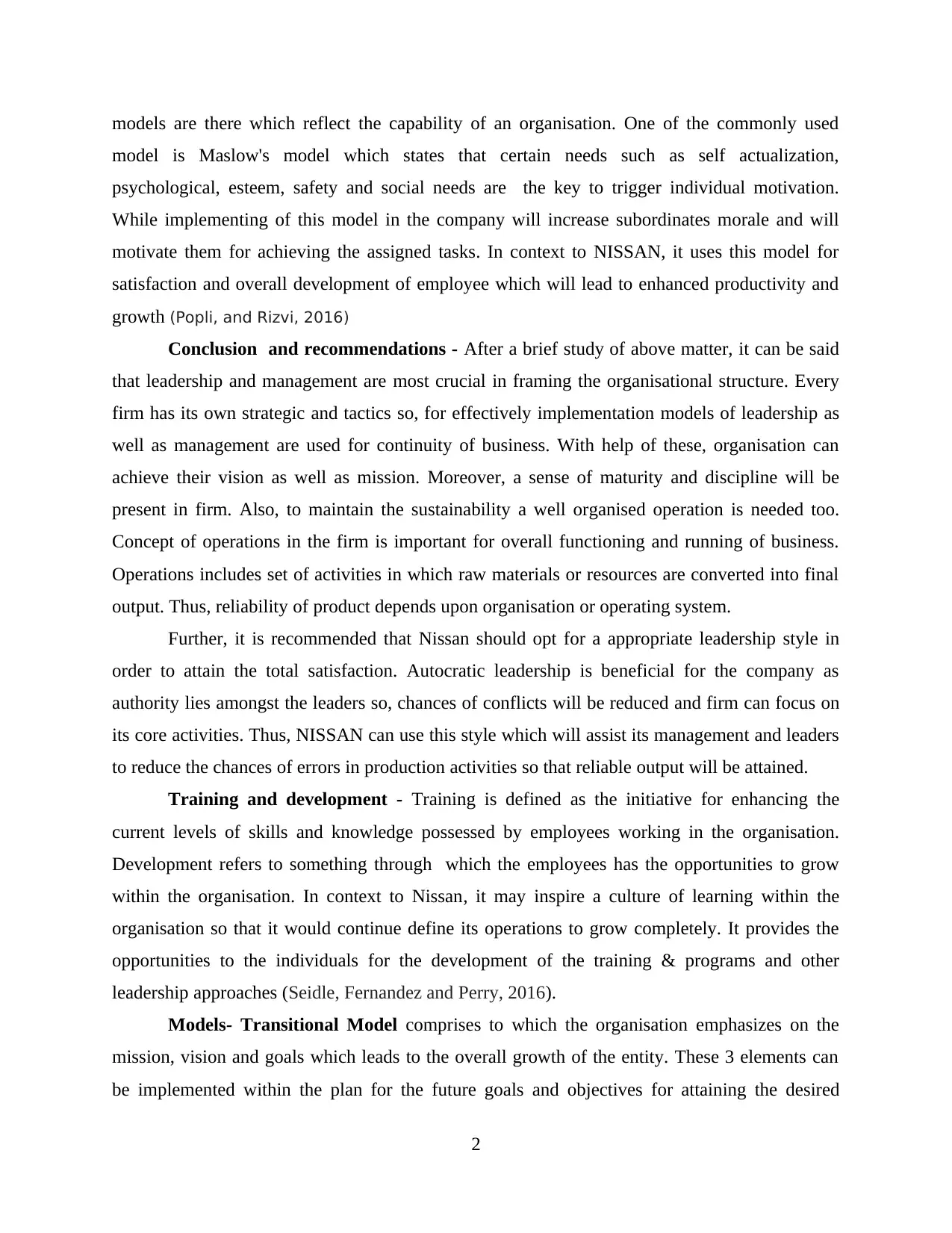
models are there which reflect the capability of an organisation. One of the commonly used
model is Maslow's model which states that certain needs such as self actualization,
psychological, esteem, safety and social needs are the key to trigger individual motivation.
While implementing of this model in the company will increase subordinates morale and will
motivate them for achieving the assigned tasks. In context to NISSAN, it uses this model for
satisfaction and overall development of employee which will lead to enhanced productivity and
growth (Popli, and Rizvi, 2016)
Conclusion and recommendations - After a brief study of above matter, it can be said
that leadership and management are most crucial in framing the organisational structure. Every
firm has its own strategic and tactics so, for effectively implementation models of leadership as
well as management are used for continuity of business. With help of these, organisation can
achieve their vision as well as mission. Moreover, a sense of maturity and discipline will be
present in firm. Also, to maintain the sustainability a well organised operation is needed too.
Concept of operations in the firm is important for overall functioning and running of business.
Operations includes set of activities in which raw materials or resources are converted into final
output. Thus, reliability of product depends upon organisation or operating system.
Further, it is recommended that Nissan should opt for a appropriate leadership style in
order to attain the total satisfaction. Autocratic leadership is beneficial for the company as
authority lies amongst the leaders so, chances of conflicts will be reduced and firm can focus on
its core activities. Thus, NISSAN can use this style which will assist its management and leaders
to reduce the chances of errors in production activities so that reliable output will be attained.
Training and development - Training is defined as the initiative for enhancing the
current levels of skills and knowledge possessed by employees working in the organisation.
Development refers to something through which the employees has the opportunities to grow
within the organisation. In context to Nissan, it may inspire a culture of learning within the
organisation so that it would continue define its operations to grow completely. It provides the
opportunities to the individuals for the development of the training & programs and other
leadership approaches (Seidle, Fernandez and Perry, 2016).
Models- Transitional Model comprises to which the organisation emphasizes on the
mission, vision and goals which leads to the overall growth of the entity. These 3 elements can
be implemented within the plan for the future goals and objectives for attaining the desired
2
model is Maslow's model which states that certain needs such as self actualization,
psychological, esteem, safety and social needs are the key to trigger individual motivation.
While implementing of this model in the company will increase subordinates morale and will
motivate them for achieving the assigned tasks. In context to NISSAN, it uses this model for
satisfaction and overall development of employee which will lead to enhanced productivity and
growth (Popli, and Rizvi, 2016)
Conclusion and recommendations - After a brief study of above matter, it can be said
that leadership and management are most crucial in framing the organisational structure. Every
firm has its own strategic and tactics so, for effectively implementation models of leadership as
well as management are used for continuity of business. With help of these, organisation can
achieve their vision as well as mission. Moreover, a sense of maturity and discipline will be
present in firm. Also, to maintain the sustainability a well organised operation is needed too.
Concept of operations in the firm is important for overall functioning and running of business.
Operations includes set of activities in which raw materials or resources are converted into final
output. Thus, reliability of product depends upon organisation or operating system.
Further, it is recommended that Nissan should opt for a appropriate leadership style in
order to attain the total satisfaction. Autocratic leadership is beneficial for the company as
authority lies amongst the leaders so, chances of conflicts will be reduced and firm can focus on
its core activities. Thus, NISSAN can use this style which will assist its management and leaders
to reduce the chances of errors in production activities so that reliable output will be attained.
Training and development - Training is defined as the initiative for enhancing the
current levels of skills and knowledge possessed by employees working in the organisation.
Development refers to something through which the employees has the opportunities to grow
within the organisation. In context to Nissan, it may inspire a culture of learning within the
organisation so that it would continue define its operations to grow completely. It provides the
opportunities to the individuals for the development of the training & programs and other
leadership approaches (Seidle, Fernandez and Perry, 2016).
Models- Transitional Model comprises to which the organisation emphasizes on the
mission, vision and goals which leads to the overall growth of the entity. These 3 elements can
be implemented within the plan for the future goals and objectives for attaining the desired
2
Paraphrase This Document
Need a fresh take? Get an instant paraphrase of this document with our AI Paraphraser
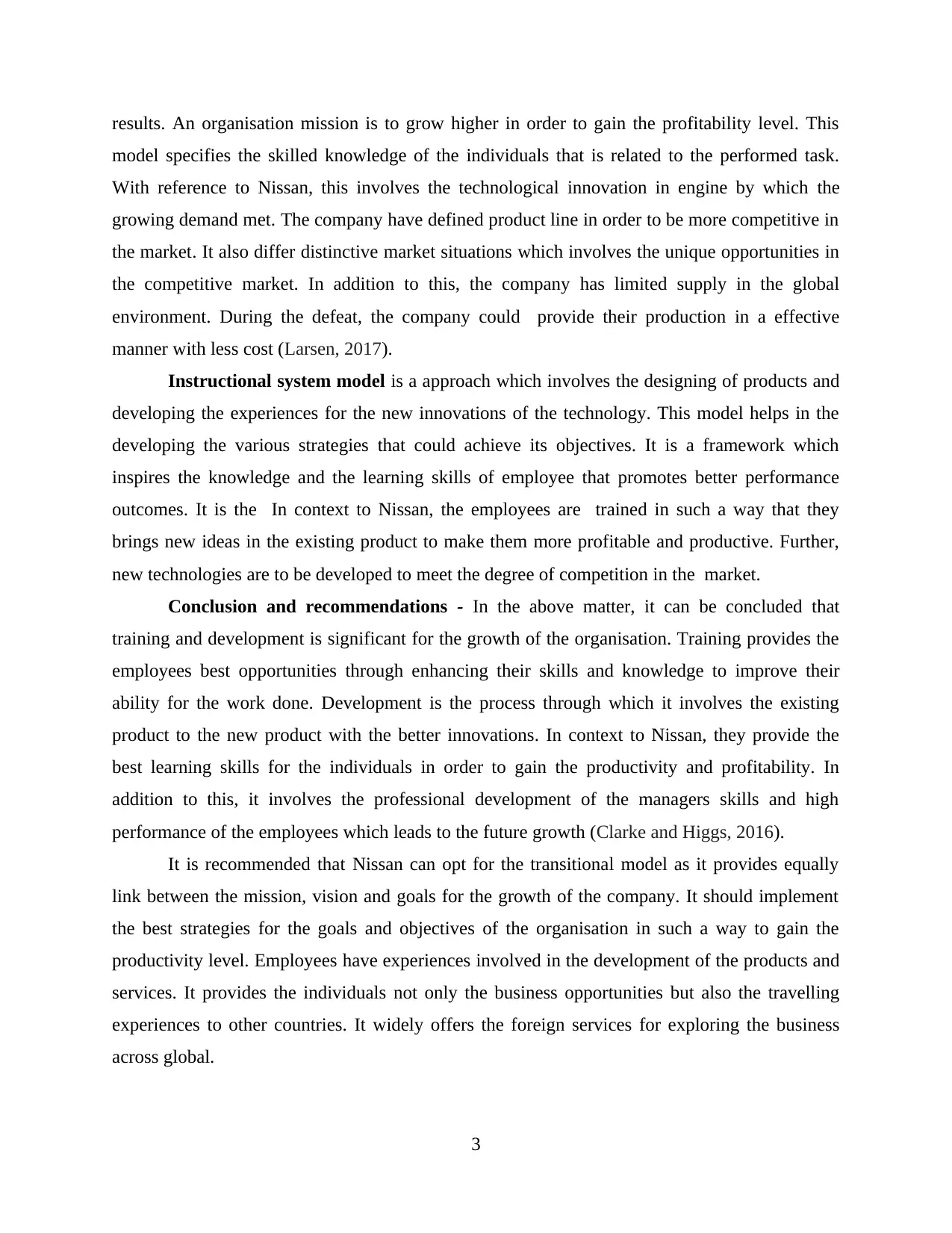
results. An organisation mission is to grow higher in order to gain the profitability level. This
model specifies the skilled knowledge of the individuals that is related to the performed task.
With reference to Nissan, this involves the technological innovation in engine by which the
growing demand met. The company have defined product line in order to be more competitive in
the market. It also differ distinctive market situations which involves the unique opportunities in
the competitive market. In addition to this, the company has limited supply in the global
environment. During the defeat, the company could provide their production in a effective
manner with less cost (Larsen, 2017).
Instructional system model is a approach which involves the designing of products and
developing the experiences for the new innovations of the technology. This model helps in the
developing the various strategies that could achieve its objectives. It is a framework which
inspires the knowledge and the learning skills of employee that promotes better performance
outcomes. It is the In context to Nissan, the employees are trained in such a way that they
brings new ideas in the existing product to make them more profitable and productive. Further,
new technologies are to be developed to meet the degree of competition in the market.
Conclusion and recommendations - In the above matter, it can be concluded that
training and development is significant for the growth of the organisation. Training provides the
employees best opportunities through enhancing their skills and knowledge to improve their
ability for the work done. Development is the process through which it involves the existing
product to the new product with the better innovations. In context to Nissan, they provide the
best learning skills for the individuals in order to gain the productivity and profitability. In
addition to this, it involves the professional development of the managers skills and high
performance of the employees which leads to the future growth (Clarke and Higgs, 2016).
It is recommended that Nissan can opt for the transitional model as it provides equally
link between the mission, vision and goals for the growth of the company. It should implement
the best strategies for the goals and objectives of the organisation in such a way to gain the
productivity level. Employees have experiences involved in the development of the products and
services. It provides the individuals not only the business opportunities but also the travelling
experiences to other countries. It widely offers the foreign services for exploring the business
across global.
3
model specifies the skilled knowledge of the individuals that is related to the performed task.
With reference to Nissan, this involves the technological innovation in engine by which the
growing demand met. The company have defined product line in order to be more competitive in
the market. It also differ distinctive market situations which involves the unique opportunities in
the competitive market. In addition to this, the company has limited supply in the global
environment. During the defeat, the company could provide their production in a effective
manner with less cost (Larsen, 2017).
Instructional system model is a approach which involves the designing of products and
developing the experiences for the new innovations of the technology. This model helps in the
developing the various strategies that could achieve its objectives. It is a framework which
inspires the knowledge and the learning skills of employee that promotes better performance
outcomes. It is the In context to Nissan, the employees are trained in such a way that they
brings new ideas in the existing product to make them more profitable and productive. Further,
new technologies are to be developed to meet the degree of competition in the market.
Conclusion and recommendations - In the above matter, it can be concluded that
training and development is significant for the growth of the organisation. Training provides the
employees best opportunities through enhancing their skills and knowledge to improve their
ability for the work done. Development is the process through which it involves the existing
product to the new product with the better innovations. In context to Nissan, they provide the
best learning skills for the individuals in order to gain the productivity and profitability. In
addition to this, it involves the professional development of the managers skills and high
performance of the employees which leads to the future growth (Clarke and Higgs, 2016).
It is recommended that Nissan can opt for the transitional model as it provides equally
link between the mission, vision and goals for the growth of the company. It should implement
the best strategies for the goals and objectives of the organisation in such a way to gain the
productivity level. Employees have experiences involved in the development of the products and
services. It provides the individuals not only the business opportunities but also the travelling
experiences to other countries. It widely offers the foreign services for exploring the business
across global.
3
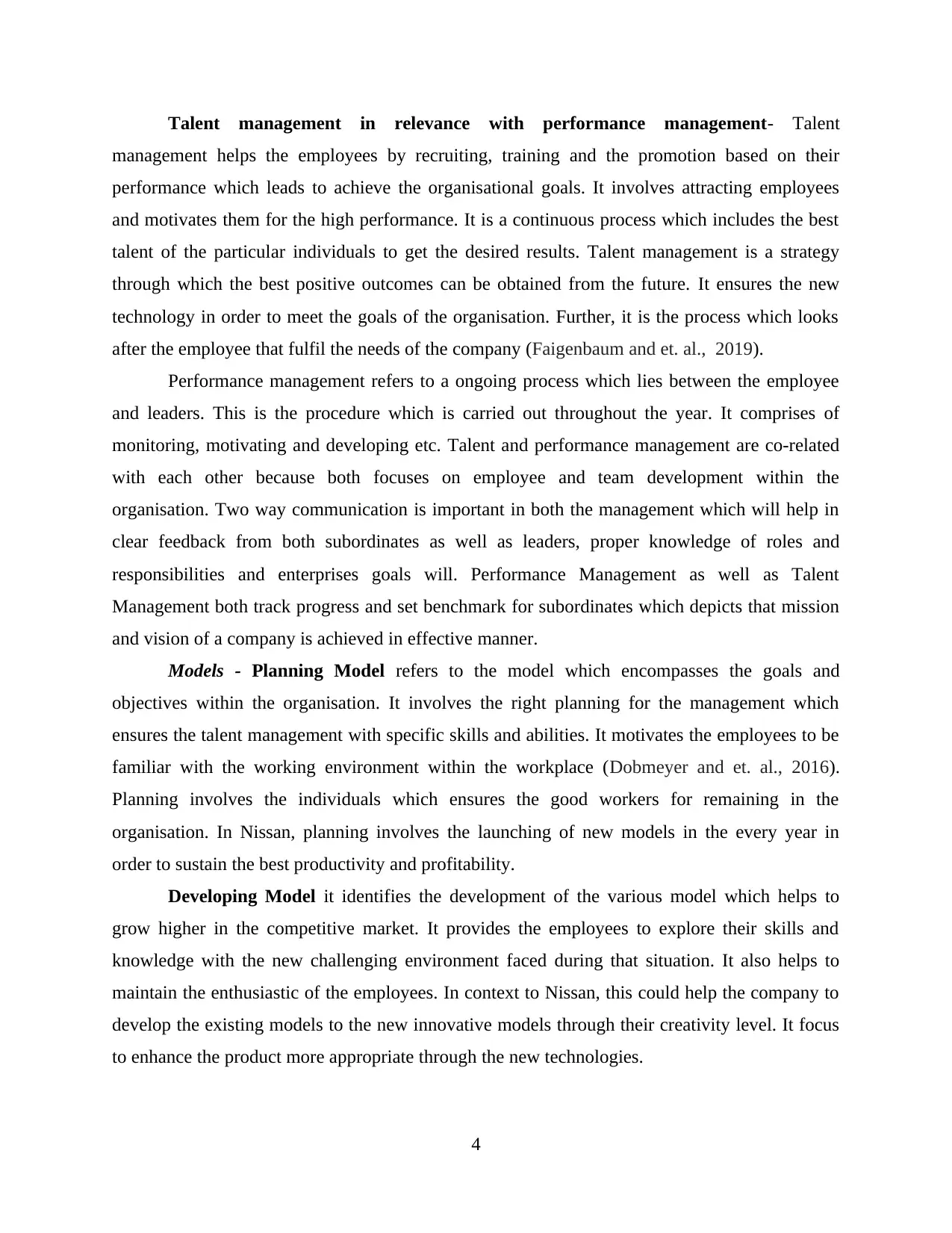
Talent management in relevance with performance management- Talent
management helps the employees by recruiting, training and the promotion based on their
performance which leads to achieve the organisational goals. It involves attracting employees
and motivates them for the high performance. It is a continuous process which includes the best
talent of the particular individuals to get the desired results. Talent management is a strategy
through which the best positive outcomes can be obtained from the future. It ensures the new
technology in order to meet the goals of the organisation. Further, it is the process which looks
after the employee that fulfil the needs of the company (Faigenbaum and et. al., 2019).
Performance management refers to a ongoing process which lies between the employee
and leaders. This is the procedure which is carried out throughout the year. It comprises of
monitoring, motivating and developing etc. Talent and performance management are co-related
with each other because both focuses on employee and team development within the
organisation. Two way communication is important in both the management which will help in
clear feedback from both subordinates as well as leaders, proper knowledge of roles and
responsibilities and enterprises goals will. Performance Management as well as Talent
Management both track progress and set benchmark for subordinates which depicts that mission
and vision of a company is achieved in effective manner.
Models - Planning Model refers to the model which encompasses the goals and
objectives within the organisation. It involves the right planning for the management which
ensures the talent management with specific skills and abilities. It motivates the employees to be
familiar with the working environment within the workplace (Dobmeyer and et. al., 2016).
Planning involves the individuals which ensures the good workers for remaining in the
organisation. In Nissan, planning involves the launching of new models in the every year in
order to sustain the best productivity and profitability.
Developing Model it identifies the development of the various model which helps to
grow higher in the competitive market. It provides the employees to explore their skills and
knowledge with the new challenging environment faced during that situation. It also helps to
maintain the enthusiastic of the employees. In context to Nissan, this could help the company to
develop the existing models to the new innovative models through their creativity level. It focus
to enhance the product more appropriate through the new technologies.
4
management helps the employees by recruiting, training and the promotion based on their
performance which leads to achieve the organisational goals. It involves attracting employees
and motivates them for the high performance. It is a continuous process which includes the best
talent of the particular individuals to get the desired results. Talent management is a strategy
through which the best positive outcomes can be obtained from the future. It ensures the new
technology in order to meet the goals of the organisation. Further, it is the process which looks
after the employee that fulfil the needs of the company (Faigenbaum and et. al., 2019).
Performance management refers to a ongoing process which lies between the employee
and leaders. This is the procedure which is carried out throughout the year. It comprises of
monitoring, motivating and developing etc. Talent and performance management are co-related
with each other because both focuses on employee and team development within the
organisation. Two way communication is important in both the management which will help in
clear feedback from both subordinates as well as leaders, proper knowledge of roles and
responsibilities and enterprises goals will. Performance Management as well as Talent
Management both track progress and set benchmark for subordinates which depicts that mission
and vision of a company is achieved in effective manner.
Models - Planning Model refers to the model which encompasses the goals and
objectives within the organisation. It involves the right planning for the management which
ensures the talent management with specific skills and abilities. It motivates the employees to be
familiar with the working environment within the workplace (Dobmeyer and et. al., 2016).
Planning involves the individuals which ensures the good workers for remaining in the
organisation. In Nissan, planning involves the launching of new models in the every year in
order to sustain the best productivity and profitability.
Developing Model it identifies the development of the various model which helps to
grow higher in the competitive market. It provides the employees to explore their skills and
knowledge with the new challenging environment faced during that situation. It also helps to
maintain the enthusiastic of the employees. In context to Nissan, this could help the company to
develop the existing models to the new innovative models through their creativity level. It focus
to enhance the product more appropriate through the new technologies.
4
⊘ This is a preview!⊘
Do you want full access?
Subscribe today to unlock all pages.

Trusted by 1+ million students worldwide
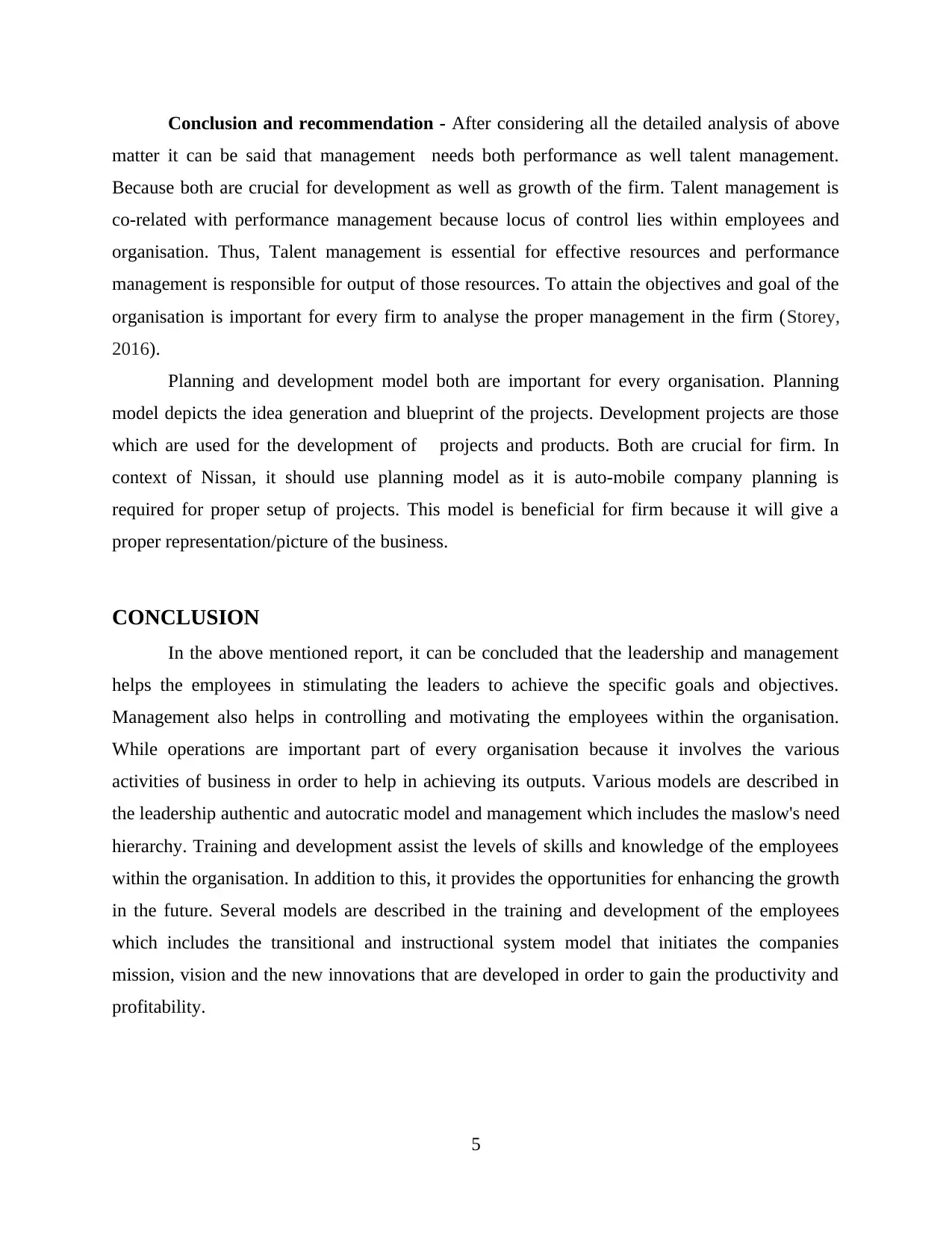
Conclusion and recommendation - After considering all the detailed analysis of above
matter it can be said that management needs both performance as well talent management.
Because both are crucial for development as well as growth of the firm. Talent management is
co-related with performance management because locus of control lies within employees and
organisation. Thus, Talent management is essential for effective resources and performance
management is responsible for output of those resources. To attain the objectives and goal of the
organisation is important for every firm to analyse the proper management in the firm (Storey,
2016).
Planning and development model both are important for every organisation. Planning
model depicts the idea generation and blueprint of the projects. Development projects are those
which are used for the development of projects and products. Both are crucial for firm. In
context of Nissan, it should use planning model as it is auto-mobile company planning is
required for proper setup of projects. This model is beneficial for firm because it will give a
proper representation/picture of the business.
CONCLUSION
In the above mentioned report, it can be concluded that the leadership and management
helps the employees in stimulating the leaders to achieve the specific goals and objectives.
Management also helps in controlling and motivating the employees within the organisation.
While operations are important part of every organisation because it involves the various
activities of business in order to help in achieving its outputs. Various models are described in
the leadership authentic and autocratic model and management which includes the maslow's need
hierarchy. Training and development assist the levels of skills and knowledge of the employees
within the organisation. In addition to this, it provides the opportunities for enhancing the growth
in the future. Several models are described in the training and development of the employees
which includes the transitional and instructional system model that initiates the companies
mission, vision and the new innovations that are developed in order to gain the productivity and
profitability.
5
matter it can be said that management needs both performance as well talent management.
Because both are crucial for development as well as growth of the firm. Talent management is
co-related with performance management because locus of control lies within employees and
organisation. Thus, Talent management is essential for effective resources and performance
management is responsible for output of those resources. To attain the objectives and goal of the
organisation is important for every firm to analyse the proper management in the firm (Storey,
2016).
Planning and development model both are important for every organisation. Planning
model depicts the idea generation and blueprint of the projects. Development projects are those
which are used for the development of projects and products. Both are crucial for firm. In
context of Nissan, it should use planning model as it is auto-mobile company planning is
required for proper setup of projects. This model is beneficial for firm because it will give a
proper representation/picture of the business.
CONCLUSION
In the above mentioned report, it can be concluded that the leadership and management
helps the employees in stimulating the leaders to achieve the specific goals and objectives.
Management also helps in controlling and motivating the employees within the organisation.
While operations are important part of every organisation because it involves the various
activities of business in order to help in achieving its outputs. Various models are described in
the leadership authentic and autocratic model and management which includes the maslow's need
hierarchy. Training and development assist the levels of skills and knowledge of the employees
within the organisation. In addition to this, it provides the opportunities for enhancing the growth
in the future. Several models are described in the training and development of the employees
which includes the transitional and instructional system model that initiates the companies
mission, vision and the new innovations that are developed in order to gain the productivity and
profitability.
5
Paraphrase This Document
Need a fresh take? Get an instant paraphrase of this document with our AI Paraphraser
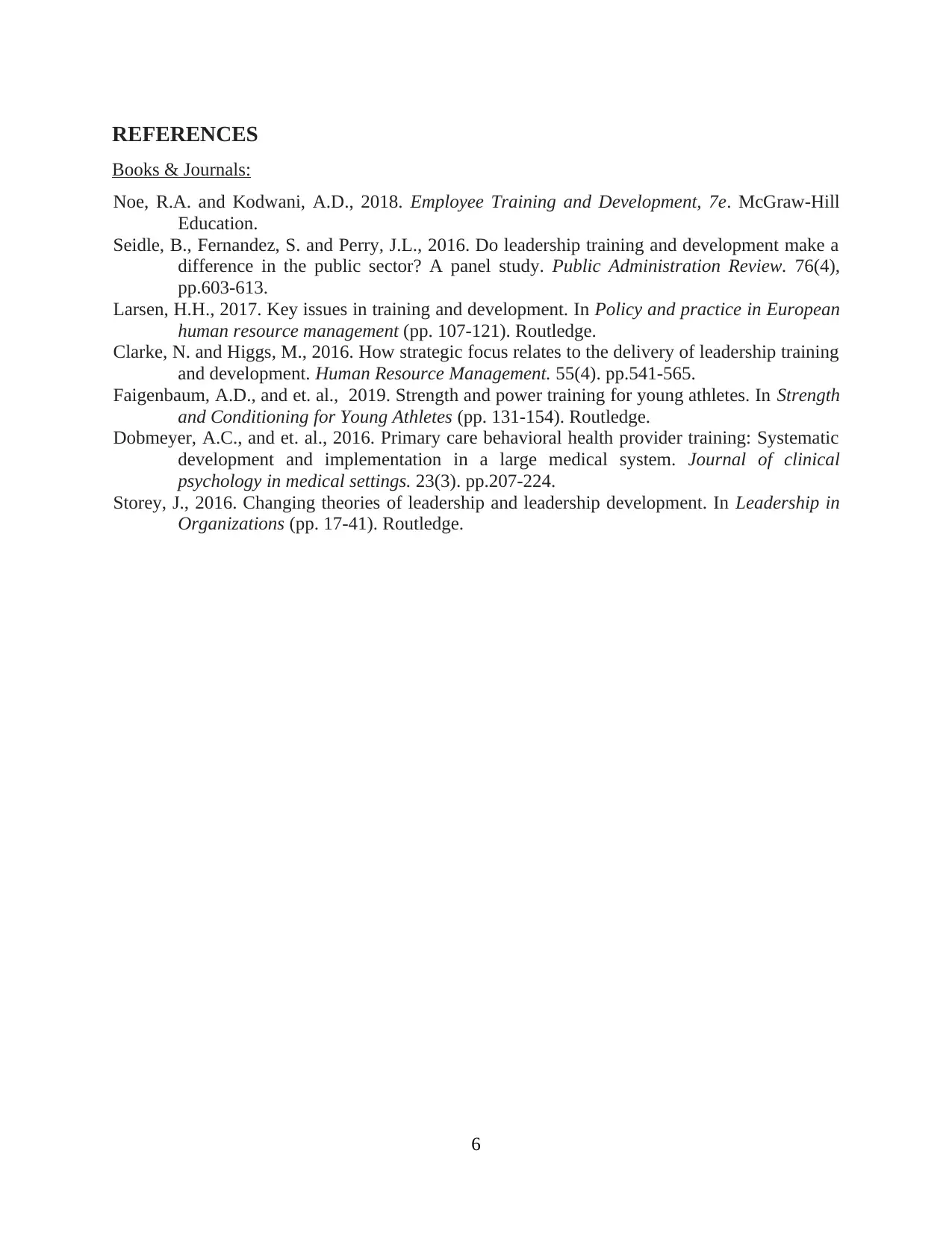
REFERENCES
Books & Journals:
Noe, R.A. and Kodwani, A.D., 2018. Employee Training and Development, 7e. McGraw-Hill
Education.
Seidle, B., Fernandez, S. and Perry, J.L., 2016. Do leadership training and development make a
difference in the public sector? A panel study. Public Administration Review. 76(4),
pp.603-613.
Larsen, H.H., 2017. Key issues in training and development. In Policy and practice in European
human resource management (pp. 107-121). Routledge.
Clarke, N. and Higgs, M., 2016. How strategic focus relates to the delivery of leadership training
and development. Human Resource Management. 55(4). pp.541-565.
Faigenbaum, A.D., and et. al., 2019. Strength and power training for young athletes. In Strength
and Conditioning for Young Athletes (pp. 131-154). Routledge.
Dobmeyer, A.C., and et. al., 2016. Primary care behavioral health provider training: Systematic
development and implementation in a large medical system. Journal of clinical
psychology in medical settings. 23(3). pp.207-224.
Storey, J., 2016. Changing theories of leadership and leadership development. In Leadership in
Organizations (pp. 17-41). Routledge.
6
Books & Journals:
Noe, R.A. and Kodwani, A.D., 2018. Employee Training and Development, 7e. McGraw-Hill
Education.
Seidle, B., Fernandez, S. and Perry, J.L., 2016. Do leadership training and development make a
difference in the public sector? A panel study. Public Administration Review. 76(4),
pp.603-613.
Larsen, H.H., 2017. Key issues in training and development. In Policy and practice in European
human resource management (pp. 107-121). Routledge.
Clarke, N. and Higgs, M., 2016. How strategic focus relates to the delivery of leadership training
and development. Human Resource Management. 55(4). pp.541-565.
Faigenbaum, A.D., and et. al., 2019. Strength and power training for young athletes. In Strength
and Conditioning for Young Athletes (pp. 131-154). Routledge.
Dobmeyer, A.C., and et. al., 2016. Primary care behavioral health provider training: Systematic
development and implementation in a large medical system. Journal of clinical
psychology in medical settings. 23(3). pp.207-224.
Storey, J., 2016. Changing theories of leadership and leadership development. In Leadership in
Organizations (pp. 17-41). Routledge.
6

7
⊘ This is a preview!⊘
Do you want full access?
Subscribe today to unlock all pages.

Trusted by 1+ million students worldwide
1 out of 9
Related Documents
Your All-in-One AI-Powered Toolkit for Academic Success.
+13062052269
info@desklib.com
Available 24*7 on WhatsApp / Email
![[object Object]](/_next/static/media/star-bottom.7253800d.svg)
Unlock your academic potential
Copyright © 2020–2025 A2Z Services. All Rights Reserved. Developed and managed by ZUCOL.





